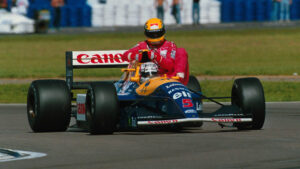Williams FW14B specs & info
Williams' F1 car for 1992
The Williams FW14B is widely regarded as one of the most dominant and technologically advanced Formula 1 cars ever built. Designed by the legendary Adrian Newey and Patrick Head, the car propelled Nigel Mansell to his first and only F1 World Championship title in 1992. In this article, we'll delve into the technical specifications and innovative features that made the FW14B a true masterpiece in the world of F1.
Chassis and Aerodynamics
The FW14B featured a carbon fiber and Kevlar composite monocoque chassis, providing exceptional rigidity and safety while maintaining a lightweight structure. Its aerodynamic design was meticulously refined in the wind tunnel, resulting in a sleek and efficient profile. The car's unique raised nose and sculpted sidepods contributed to its impressive downforce levels, giving drivers greater control and stability at high speeds.
Engine and Transmission
Powering the FW14B was a naturally aspirated 3.5-liter Renault RS3 V10 engine, capable of producing over 760 horsepower at 14,500 RPM. The engine was renowned for its reliability and performance, contributing to the car's dominance throughout the 1992 F1 season. The power unit was mated to a semi-automatic, six-speed Williams transverse gearbox, which offered seamless gear changes and improved shift times compared to its manual counterparts.
Suspension and Electronics
One of the key innovations that set the FW14B apart from its competition was the introduction of active suspension. This electronically controlled system allowed for real-time adjustments to the car's ride height and damping, optimising its handling characteristics to suit varying track conditions and driver preferences. The active suspension system not only improved cornering stability but also reduced tire wear, providing a significant competitive advantage.
The FW14B also incorporated advanced electronic systems for traction control and engine management. These cutting-edge technologies allowed drivers to better manage the car's immense power while minimising wheelspin, ultimately enhancing performance and drivability.
Brakes and Tires
The car's braking system consisted of carbon fiber-reinforced carbon disc brakes, providing exceptional stopping power and heat dissipation. The brakes were paired with Goodyear tires, which offered excellent grip and durability, contributing to the FW14B's overall performance on track.
Legacy
The Williams FW14B's remarkable success in the 1992 F1 season cemented its place in motorsport history. With ten Grand Prix victories, six of which were achieved by Nigel Mansell, the FW14B dominated the competition and helped Mansell secure his first Drivers' Championship title. The car's technological innovations and unparalleled performance set new benchmarks in Formula 1, inspiring future generations of racing machines.
In conclusion, the Williams FW14B stands as a testament to the power of engineering and innovation in the world of Formula 1. Its groundbreaking features and dominant performance make it an enduring icon in the annals of motorsport history.












LAST 3 F1 Fan COMMENTS